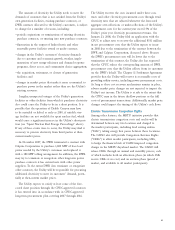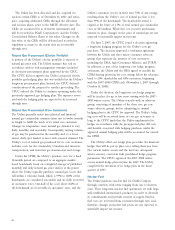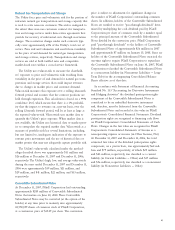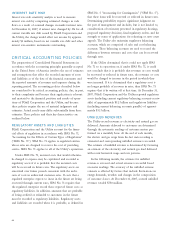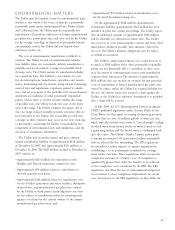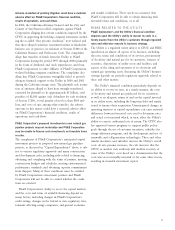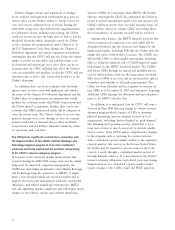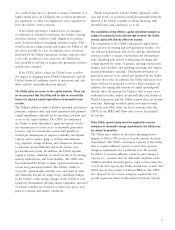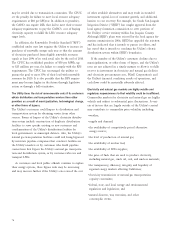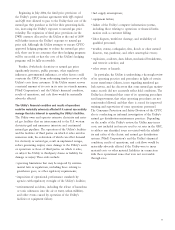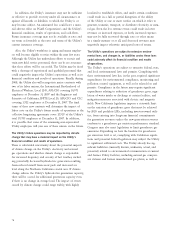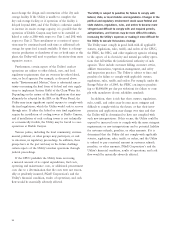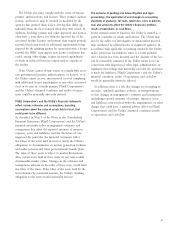PG&E 2007 Annual Report Download - page 73
Download and view the complete annual report
Please find page 73 of the 2007 PG&E annual report below. You can navigate through the pages in the report by either clicking on the pages listed below, or by using the keyword search tool below to find specific information within the annual report.71
Adverse resolution of pending litigation could have a material,
adverse effect on PG&E Corporation’s fi nancial condition,
results of operations, and cash fl ows.
In 2002, the California Attorney General and the City and
County of San Francisco fi led complaints against PG&E
Corporation alleging that certain conditions imposed by the
CPUC in approving the holding company formation, includ-
ing the so-called “fi rst priority condition,” were violated and
that these alleged violations constituted unfair or fraudulent
business acts or practices in violation of Section 17200 of the
California Business and Professions Code. The complaints
allege that transfers of funds from the Utility to PG&E
Corporation during the period 1997 through 2000 (primarily
in the form of dividends and stock repurchases), and from
PG&E Corporation to other affi liates of PG&E Corporation,
violated holding company conditions. The complaints also
allege that PG&E Corporation wrongfully failed to provide
adequate fi nancial support to the Utility in 2000 and 2001
during the California energy crisis. The plaintiffs seek restitu-
tion of amounts alleged to have been wrongly transferred,
estimated by plaintiffs to be approximately $5 billion, civil
penalties of $2,500 against each defendant for each violation
of Section 17200, a total penalty of not less than $500 mil-
lion, and costs of suit, among other remedies. An adverse
outcome in this matter could have a material, adverse affect
on PG&E Corporation’s fi nancial condition, results of
operations, and cash fl ows.
PG&E Corporation’s proposed investments in new natural gas
pipeline projects may not materialize and PG&E Corporation
may be unable to fi nance such investments on favorable terms
or rates.
The completion of PG&E Corporation’s anticipated capital
investment projects in proposed new natural gas pipelines
projects, as discussed in “Capital Expenditures” above, is sub-
ject to various regulatory approvals and many construction
and development risks, including risks related to fi nancing,
obtaining and complying with the terms of permits, meeting
construction budgets and schedules, meeting environmental
performance standards, and obtaining capacity commitments
from shippers. Many of these conditions must be satisfi ed
by PG&E Corporation’s investment partners and PG&E
Corporation will not be able to control whether the condi-
tions are satisfi ed.
PG&E Corporation’s ability to access the capital markets
and the costs and terms of available fi nancing depend on
many factors, including changes in PG&E Corporation’s
credit ratings, changes in the federal or state regulatory envi-
ronment affecting energy companies, and general economic
and market conditions. There can be no assurance that
PG&E Corporation will be able to obtain fi nancing with
favorable terms and conditions, or at all.
RISKS RELATED TO THE UTILITY
PG&E Corporation’s and the Utility’s fi nancial condition
depends upon the Utility’s ability to recover its costs in a
timely manner from the Utility’s customers through regulated
rates and otherwise execute its business strategy.
The Utility is a regulated entity subject to CPUC and FERC
jurisdiction in almost all aspects of its business, including
the rates, terms and conditions of its services, procurement
of electricity and natural gas for its customers, issuance of
securities, dispositions of utility assets and facilities, and
aspects of the siting and operation of its electricity and
natural gas operating assets. Executing the Utility’s business
strategy depends on periodic regulatory approvals related to
these and other matters.
The Utility’s fi nancial condition particularly depends on
its ability to recover in rates, in a timely manner, the costs
of electricity and natural gas purchased for its customers,
as well as an adequate return of and on the capital invested
in its utility assets, including the long-term debt and equity
issued to fi nance their acquisition. Unanticipated changes in
operating expenses or capital expenditures can cause material
differences between forecasted costs used to determine rates
and actual costs incurred which, in turn, affect the Utility’s
ability to earn its authorized rate of return. The CPUC also
has approved various programs to support public policy
goals through the use of customer incentives, subsidies for
energy effi ciency programs, and the development and use of
renewable and self-generation technologies. These and other
similar incentives and subsidies increase the Utility’s overall
costs. As rate pressure increases, the risk increases that the
CPUC or another state authority will disallow recovery of
some of the Utility’s costs based on a determination that the
costs were not reasonably incurred or for some other reason,
resulting in stranded investment capital.


